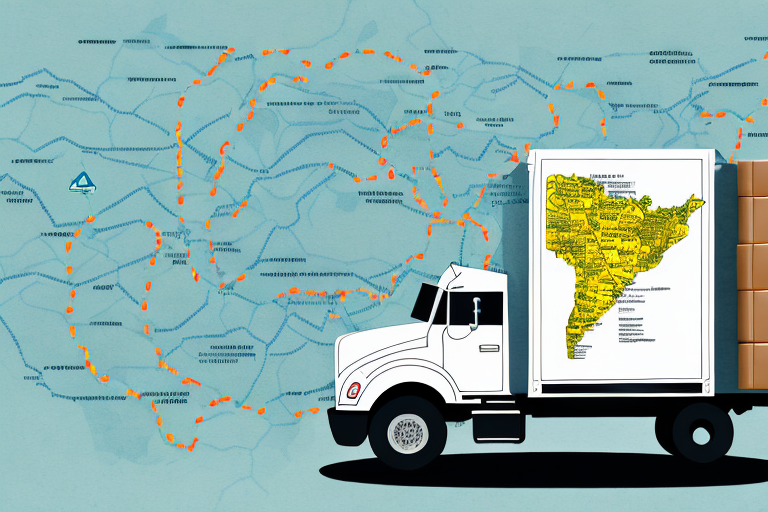Understanding Courier Costs: A Comprehensive Guide
As a business owner, ensuring timely and secure delivery of your products is crucial. However, the cost of using courier services can significantly impact your bottom line if not carefully managed. This comprehensive guide delves into the intricacies of courier costs, offering insights on calculating expenses, negotiating rates, uncovering hidden fees, and selecting the right service provider for your business needs.
How to Calculate Courier Costs for Your Business
Accurately calculating courier costs is essential for budgeting and pricing your products effectively. Understanding the factors that influence these costs allows you to make informed decisions when selecting courier services.
Key Components of Courier Pricing
- Distance: The longer the distance, the higher the cost.
- Weight and Size: Heavier and larger packages incur higher fees.
- Delivery Speed: Faster delivery options like same-day or next-day delivery are more expensive.
Using a Courier Cost Calculator
To streamline the calculation process, utilize a courier cost calculator. Input the package's weight, dimensions, and destination to get an accurate estimate of shipping costs.
Additional Costs to Consider
- Insurance: Protects against loss or damage. Standard coverage is often included, but additional coverage may be necessary for high-value items.
- Special Services: Fees for same-day delivery, weekend delivery, or delivery to remote areas.
According to the 2023 Statista report, businesses have seen a 5% increase in courier costs annually due to rising fuel prices and labor costs.
Factors That Affect Courier Pricing
Understanding the diverse elements that influence courier pricing can help you anticipate costs and identify opportunities for savings.
Primary Influencers
- Distance: Domestic vs. international shipments.
- Weight and Dimensions: Larger and heavier packages cost more to ship.
- Delivery Speed: Expedited services come at a premium.
- Delivery Location: Urban vs. rural addresses may have different rates.
- Insurance and Tracking: Enhanced tracking and insurance options add to the cost.
Timing and Demand
Delivery during peak hours or high-demand periods can increase costs. For instance, shipping during holiday seasons often incurs higher fees due to increased demand.
Destination Challenges
Delivering to remote or hard-to-reach locations may require additional resources, leading to higher costs. According to UPS Economic Reports, deliveries to remote areas can cost up to 20% more than standard locations.
Types of Courier Services and Their Costs
Courier services vary in terms of speed, reliability, and cost. Selecting the right type depends on your business needs and budget constraints.
Standard Delivery
The most cost-effective option, suitable for non-urgent shipments. Typically, deliveries take 3-5 business days.
Same-Day Delivery
Ideal for urgent shipments that need to arrive on the same day. This premium service is the most expensive option.
Next-Day Delivery
Offers a balance between speed and cost, making it a popular choice for businesses requiring quick turnover.
Specialized Services
- International Delivery: For global shipments, varying costs based on destination and customs requirements.
- Temperature-Controlled Delivery: Essential for perishable goods, incurring higher costs.
- White-Glove Delivery: Provides extra care for high-value or fragile items, at a higher price point.
For more details on specialized services, visit Specialized Courier Services.
Negotiating Better Courier Rates
For businesses with high shipping volumes, negotiating better rates with courier providers can lead to significant savings.
Strategies for Negotiation
- Research Market Rates: Understand the standard rates to leverage better deals.
- Show Loyalty: Consistently using a provider's services can make them more amenable to discounts.
- Long-Term Contracts: Committing to longer agreements may result in lower rates.
- Provide Detailed Shipping Data: Helping providers optimize their services based on your shipping patterns.
- Use Third-Party Services: Employing negotiation services to secure the best rates.
Balancing cost with service quality is crucial. Ensure that discounted rates do not compromise reliability and customer service.
Understanding Hidden Fees in Courier Pricing
Courier pricing often includes additional fees that can inflate overall costs. Being aware of these hidden charges helps in accurate budgeting.
Common Hidden Fees
- Fuel Surcharges: Adjust based on fluctuating fuel prices.
- Weekend Delivery Fees: Additional charges for deliveries made on weekends.
- Residential Delivery Fees: Higher costs for deliveries to residential addresses.
- Handling Fees: For oversized or fragile packages requiring extra care.
Avoiding Unexpected Costs
Always request a detailed pricing breakdown from your courier provider and scrutinize contracts for any hidden fees. Utilize a courier cost calculator that accounts for potential hidden fees.
Tips for Reducing Courier Costs Without Compromising Quality
Minimizing courier expenses is achievable without sacrificing service quality by implementing strategic practices.
Effective Cost-Reduction Strategies
- Consolidate Shipments: Combine multiple orders into a single shipment to reduce costs.
- Select Cost-Effective Delivery Options: Choose the most economical shipping method that meets your delivery timelines.
- Accurate Package Measurements: Prevent overpaying by providing precise weight and size details.
- Optimize Packaging: Use compact and lightweight packaging to reduce shipping costs.
- Compare Rates: Regularly compare rates from different courier providers using a courier cost comparison tool.
Leverage Technology
Implementing shipping software can automate processes, reduce errors, and identify cost-saving opportunities. Tools like shipping software help manage logistics efficiently.
Additionally, tracking shipments ensures timely deliveries and minimizes costs associated with lost or damaged packages.
Choosing the Right Courier Service for Your Business Needs
Selecting the appropriate courier service is pivotal for maintaining customer satisfaction and controlling costs.
Considerations for Selection
- Service Level and Flexibility: Ensure the provider can accommodate your specific delivery requirements.
- Reputation: Opt for providers known for reliability and excellent customer service.
- Service Offerings: Evaluate the range of delivery options and specialized services available.
- Pricing Structure: Understand the fee model and ensure it aligns with your budget.
- Insurance and Tracking: Ensure comprehensive coverage and real-time tracking capabilities.
Coverage Area
Verify that the courier service covers all the areas you intend to ship to, including international destinations if necessary. Limited coverage can lead to delays and increased costs.
For international shipping, familiarize yourself with each country's customs regulations, duties, and taxes to avoid unexpected expenses. Resources such as the Canada Border Services Agency provide detailed information on customs requirements.
International Shipping: Understanding Customs, Duties, and Taxes
Shipping internationally introduces additional complexities, including customs clearance, duties, and taxes that can affect overall costs.
Customs Fees
These are charges imposed by the destination country's government to process the import of goods. Fees vary based on the item's value, type, and origin.
Duties and Taxes
Duties: Taxes on imported goods, calculated as a percentage of the item's value.
Taxes: Applicable taxes on goods sold or consumed, which can vary by country and product category.
Compliance and Documentation
Ensure all shipments comply with international regulations by providing accurate documentation, including invoices, shipping labels, and any required permits.
Failure to comply can result in delays, fines, or even confiscation of goods. For comprehensive guidelines, refer to the U.S. Customs and Border Protection website.
The Impact of Package Size and Weight on Courier Costs
The size and weight of your packages play a significant role in determining courier costs. Optimizing these factors can lead to substantial savings.
Optimizing Package Dimensions
Use the smallest possible packaging that safely accommodates your products. Avoid excess space by utilizing appropriate packing materials.
Managing Weight
Reduces costs by selecting lighter packaging and materials. For heavy items, explore bulk shipping options that offer better rates for higher weights.
Cost Implications
According to Insurance Journal, package size and weight account for up to 70% of the total shipping cost, making optimization a critical cost-saving measure.
Tracking and Insurance Options for Courier Shipments
Tracking and insurance are essential for safeguarding your shipments and ensuring accountability.
Tracking Services
Real-time tracking allows you and your customers to monitor the shipment's progress, enhancing transparency and trust.
Insurance Coverage
Protects against loss, theft, or damage. Basic insurance is typically included, but additional coverage may be necessary for high-value or fragile items.
Choosing the Right Provider
Select a courier that offers robust tracking systems and comprehensive insurance options to meet your business needs.
Understanding Delivery Speed Options and Their Costs
Delivery speed options affect both customer satisfaction and shipping costs. Balancing speed with cost is crucial for maintaining profitability.
Available Speed Options
- Standard Delivery: Economical but slower, suitable for non-urgent shipments.
- Expedited Delivery: Faster than standard, ideal for time-sensitive deliveries.
- Same-Day Delivery: Immediate delivery for urgent needs, at a premium cost.
Cost Considerations
Expedited and same-day delivery options come with higher costs. Assess your business needs to determine the most cost-effective delivery speed that satisfies your customers.
How to Optimize Your Shipping Processes to Reduce Costs
Streamlining your shipping processes can lead to significant cost reductions and improved efficiency.
Automation
Automate shipping processes to minimize manual labor and errors. Tools like shipping software assist in managing logistics effectively.
Optimized Packaging
Design packaging to reduce size and weight without compromising product safety. This strategy lowers shipping costs and improves handling efficiency.
Shipment Consolidation
Combine multiple orders into a single shipment to decrease the number of deliveries, thereby reducing costs.
Utilize Technology
Employ tracking and analytics tools to monitor shipping performance and identify areas for improvement. Technologies such as analytics tools provide insights into shipping patterns and cost-saving opportunities.
The Role of Technology in Managing and Reducing Courier Costs
Technology is a pivotal element in modern shipping, offering tools that enhance efficiency and reduce costs.
Shipping Software
Automation and integration capabilities streamline shipping processes, from order management to delivery tracking. Solutions like shipping software provide comprehensive management features.
Automated Tracking Systems
Real-time tracking enhances transparency and allows for proactive handling of delivery issues.
Analytics and Reporting
Data-driven insights from analytics tools help identify inefficiencies and optimize shipping strategies for cost savings.
Best Practices for Managing and Optimizing Your Courier Expenses
Effective management and optimization of courier expenses are vital for maintaining profitability and ensuring customer satisfaction.
Tracking and Analysis
Monitor and analyze shipping expenses regularly to identify trends and areas for cost reduction. Utilize expense tracking tools for accurate reporting.
Cost-Effective Shipping Options
Select the most economical shipping methods that align with your delivery timelines and customer expectations.
Rate Negotiation
Engage in regular negotiations with service providers to secure favorable rates and contract terms.
Process Optimization
Enhance packaging methods and shipping workflows to minimize costs without compromising quality.
Leverage Technology
Implement advanced technologies to automate operations, reduce errors, and uncover cost-saving opportunities.
By adhering to these best practices and understanding the various factors influencing courier costs, businesses can effectively reduce shipping expenses while maintaining high service standards.






















